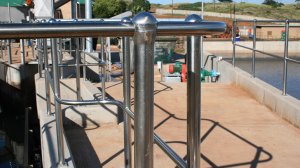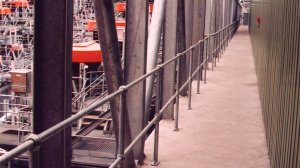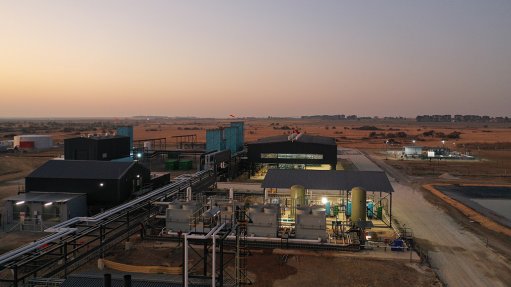Stainless steel improves handrailing safety



BENEFICIAL MATERIAL Stainless steel handrailing offers numerous benefits among which is increased safety
SUITABLE FOR HARSH ENVIRONMENTS Stainless steel handrailing exhibits high levels of corrosion resistance making it suitable for use in rigorous environments
Stainless steel handrailing can be used in various industries to ensure the safety of personnel and company compliance with hygiene standards, says precision engineering company Andrew Mentis.
The company notes that hygiene and safety concerns continue to plague a number of market sectors and cost companies thousands of rands every year in downtime and lost profits.
Andrew Mentis marketing manager Elaine van Rooyen says stainless steel tube, therefore, offers many advantages to the manufacturing, petrochemicals and chemicals, food and beverage and pharmaceuticals sectors.
“Stainless steel can be used in rigorous environments, retaining strength at high temperatures,” she says, adding that its nonporous properties offer a hygienic surface, which, when coupled with its easy cleaning ability, makes stainless steel tube the primary choice for applications that require strict hygiene control, such as food and beverage processing plants.
The aesthetic appearance of stainless steel’s polished surface is not only an added benefit, providing a modern and attractive appearance for most architectural metal applications, but it also increases ease of maintenance and provides improved corrosion performance. This not only enhances the long-term value created by stainless steel and its long useful life cycle, but, as rusting handrailing can be a major factor in accidents, it also increases the safety factor.
Handrails are expected to meet both structural safety and aesthetic requirements. Traditional carbon steel, cast iron and aluminium handrails can deteriorate quickly in exterior or industrial installations with aggressive pollution and/or chloride exposure.
Andrew Mentis provides a variety of handrails in three alternative grades: 3CR12, 304 and 316 stainless steel.
Stanchions on the Andrew Mentis stainless steel handrails are 45 mm in diameter with a 2 mm wall thickness and base plates are designed to allow moisture to drain from the stanchion itself, adding to the corrosion resistance benefits. The centre hole for the knee rail is drilled and then flared on both sides. The top is also flared and a half-round cap is welded into place. The base plate is 8 mm thick and welded to the tube.
Hand- and knee-rails and bends are manufactured from 31.8-mm-diameter tubes with a 1.5 mm wall thickness. Bends and closures have swaged ends, improving speed of installation and preventing moisture from penetrating into the joints.
Van Rooyen notes that, typically, the more corrosion-resistant Type 316 stainless steel handrails are the most cost-effective choice in demanding environments. “They require minimal maintenance, no paint or coating and provide safety and an attractive appearance. The service life of carbon steel and aluminium is typically limited by corrosion damage, which reduces structural integrity and appearance. She points out that an important aspect of structural integrity is the perceived ability of a handrail to withstand the load associated with one or more large persons or individuals accidentally falling against or climbing on it. In general applications, where corrosion is not a big factor, stainless steel handrailing can remain in place with little or no maintenance for many years. In more corrosive environments, for example, close proximity to the sea or in locations with aggressive pollution and/or chloride exposure, 316 stainless steel provides major maintenance cost savings over other handrail types.
“Customised advice by our team of technical specialists ensures that the best handrail material is selected for the customer’s specific application. Factors such as environmental conditions, amount of human traffic and aesthetics come into play and dictate the final product used. Solutions for even the most arduous conditions are available,” concludes Van Rooyen.Article Enquiry
Email Article
Save Article
Feedback
To advertise email advertising@creamermedia.co.za or click here
Comments
Press Office
Announcements
What's On
Subscribe to improve your user experience...
Option 1 (equivalent of R125 a month):
Receive a weekly copy of Creamer Media's Engineering News & Mining Weekly magazine
(print copy for those in South Africa and e-magazine for those outside of South Africa)
Receive daily email newsletters
Access to full search results
Access archive of magazine back copies
Access to Projects in Progress
Access to ONE Research Report of your choice in PDF format
Option 2 (equivalent of R375 a month):
All benefits from Option 1
PLUS
Access to Creamer Media's Research Channel Africa for ALL Research Reports, in PDF format, on various industrial and mining sectors
including Electricity; Water; Energy Transition; Hydrogen; Roads, Rail and Ports; Coal; Gold; Platinum; Battery Metals; etc.
Already a subscriber?
Forgotten your password?
Receive weekly copy of Creamer Media's Engineering News & Mining Weekly magazine (print copy for those in South Africa and e-magazine for those outside of South Africa)
➕
Recieve daily email newsletters
➕
Access to full search results
➕
Access archive of magazine back copies
➕
Access to Projects in Progress
➕
Access to ONE Research Report of your choice in PDF format
RESEARCH CHANNEL AFRICA
R4500 (equivalent of R375 a month)
SUBSCRIBEAll benefits from Option 1
➕
Access to Creamer Media's Research Channel Africa for ALL Research Reports on various industrial and mining sectors, in PDF format, including on:
Electricity
➕
Water
➕
Energy Transition
➕
Hydrogen
➕
Roads, Rail and Ports
➕
Coal
➕
Gold
➕
Platinum
➕
Battery Metals
➕
etc.
Receive all benefits from Option 1 or Option 2 delivered to numerous people at your company
➕
Multiple User names and Passwords for simultaneous log-ins
➕
Intranet integration access to all in your organisation


















